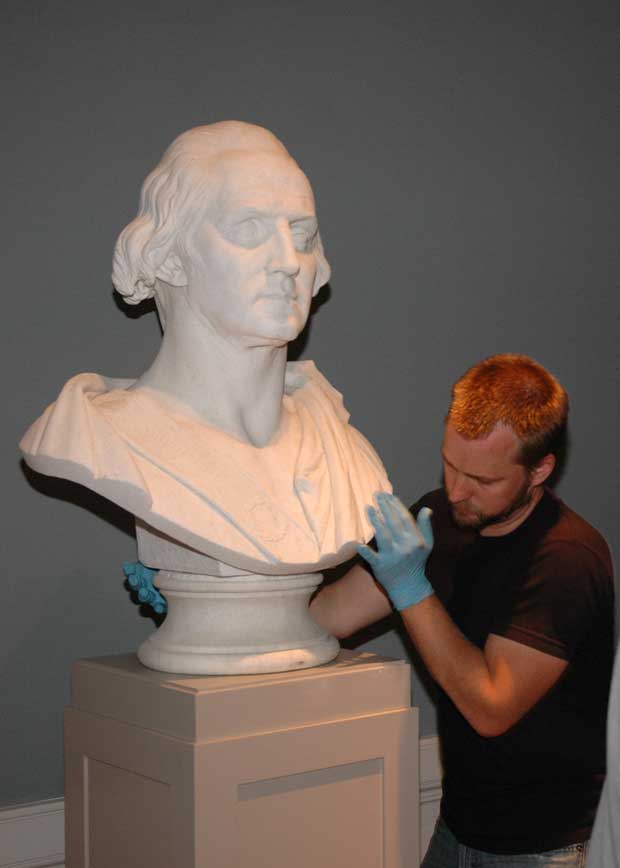The Huntington’s blog takes you behind the scenes for a scholarly view of the collections.
A New Home for a Storied Piece of Marble
Posted on Wed., June 8, 2011 by
While The Huntington was closed to visitors on Tuesday, a crew of several preparators and curators mounted a big 400-pound marble bust of George Washington in the upstairs hallway of the Huntington Art Gallery. It's a beauty. But what's interesting about the larger-than-life portrait of the first president is the back story.
It appears the sculpture, dated 1832, was made by the top portrait sculptor in France at the time, Pierre-Jean David, called David d'Angers (1788–1856). It was commissioned by the French government as a gift to the United States. (France and the United States were very friendly at the time—having mutual sympathies surrounding their struggles against tyranny with the War of Independence and French Revolution.)
The bust is documented as having been on display in the Library of Congress, which was then located in the Capitol building in Washington, D.C., when a devastating fire broke out there in 1851 and gutted the place. It seems David d'Angers' bust of Washington was thought ruined beyond repair and discarded with other debris from the fire. It then reportedly made its way to a residential backyard (How? We don't know!), where it remained until 1914, when it was, incredibly, sold as scrap marble. The hunk of marble later was purchased by a New York art dealer, and its identity as the sculpture by David d'Angers from the Capitol building was argued in an article in Art and Archeology magazine in 1918. Henry Huntington bought the bust in 1924.
While this story has been supported in art historical books, news articles, and other documents (including letters from the artist), the Library of Congress has no record of the piece having been there.
So, when Catherine Hess, chief curator of European art at The Huntington, sent the work off to conservator John Griswold for treatment and analysis, she received a nice surprise. He reported that the bust had been subjected to intense heat, possibly a fire, thereby providing scientific evidence supporting what was in the files.
"We always believed what we had was a work of high quality," said Hess. "David d'Angers was a prolific portraitist whose suave style moved beyond the more austere Neoclassical taste of the turn of the 19th century. I love his work and was eager to put it back on display. The evidence suggesting it had been in the Capitol building makes it all the more exciting. This is an incredible tale that's played out over almost two centuries, and one we're thrilled to share with Huntington visitors."
George has been through a lot. Maybe now he can enjoy a nice long stay in his new home—under a spotlight, in front of freshly painted walls, and among other great works of European art.
You can read more about the bust, including a timeline, in The Huntington's Press Room.
Thea M. Page is art writer and special projects manager at The Huntington.
